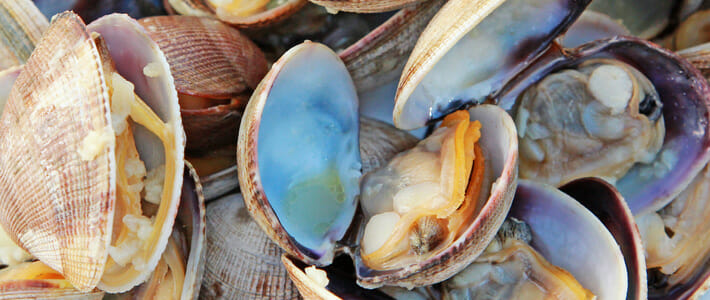Clams
Mercenaria mercenaria

The hard-shell clam is characterized by two hinged shells and two siphons. One siphon exists to intake algae and plankton for nourishment and another for expelling filtered water. Little necks, cherrystones, top necks, chowder clams, pumpkins, and ocean quahogs are all hard-shell clams or quahogs (all Atlantic clams are quahogs), having different names to designate sizes. Little necks are the smallest, most tender and most expensive. They are eaten raw on the half-shell as are cherrystones, which are medium sized. Top necks are medium-large which are sometimes cooked, usually as stuffed clams. Chowder clams are the largest, toughest, and least expensive, and are used in soups, fritters, and clam cakes. Pumpkins are huge chowder clams, and ocean quahogs are dark clams primarily used in chowders. Clams from northern waters are generally smaller and preferable to those from the south.
Product pdf for download-
3.5 oz (100g) raw edible portion
-
Calories 60
-
Calories from Fat 9
-
Total Fat 1g/2%
-
Saturated Fat 0.2g/1%
-
Cholesterol 40mg/13%
-
Sodium 56mg/2%
-
Total Carbohydrates 0g/0%
-
Protein 9.2g
-
Potassium 314mg
Texture
Hard-shell clams are firm and resilient.
Quality Control
Clams will live for several days if kept refrigerated. Live clams are easier to shuck if held in the freezer for 5 to 10 minutes before shucking. A live hard-shell clam closes tightly if it is tapped. If it opens easily or stays open, it should be discarded as it is dead, and dead clams are unsafe to eat. Also, frozen clams must be served immediately upon thawing. If they are allowed to warm up, bacteria can grow rapidly. Because clams are filter feeders, they can become contaminated by toxins and bacteria or naturally occurring algae in the water (red tide). Clams exposed to it may harbor the microorganism that causes paralytic shellfish poisoning. The National Shellfish Sanitation Program monitors the waters. By doing business with a dealer showing tags proving the clams were taken from certified waters, buyers can be assured of the quality of the clams. If clams are exposed to fresh water, they will die, so they should not be covered with ice. Clams will live for several days if kept refrigerated. Live clams are easier to shuck if held in the freezer for 5 to 10 minutes before shucking.
Preparation
Smaller clams are served raw on the half-shell, fried, or steamed while larger clams are usually chopped and stuffed or used in soups, chowders, and fritters.
Interesting fact
Hard-shell clams were used as a currency when early European settlers began trading with the Indians in the U.S. in the mid 1600s.
Alternatives
There are several hard-shell clams from which to choose.
Source
Hard-shell clams can be found from Eastern Canada to the Gulf Coast. Areas from Cape Cod to New Jersey produce many of these clams.
Harvest Method
Commercial clams are harvested by hydraulic dredges equipped with high pressure jets.
Harvest Season
Although clams are available year-round, they are tastier and plumper during the cooler weather. They spawn during warmer weather, becoming thin and less sweet. But with Frugé Seafood, you can order wholesale clams any time of the year.
Flavor
Fresh little necks and cherrystones are sweet and briny.
Market Segments
Hard-shell clams are appropriate for casual dining, fine dining, hotels and resorts.